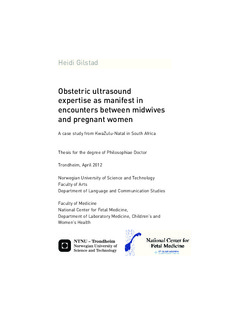| dc.description.abstract | In developed countries, most pregnant women have access to obstetric ultrasound in the course of their pregnancy. In developing countries, however, this is not yet a commonly available service for pregnant women. One of the reasons for this is that healthcare professionals have not been offered adequate training in the use of the technology. In 2004, an educational programme in obstetric ultrasound was offered to advanced midwives in KwaZulu-Natal in South Africa in order to build up sustainable ultrasound services to pregnant women.
The aim of this thesis is to describe and assess how the expertise of the advanced midwives who participated during the Educational Programme was manifest in their communication with pregnant women in ultrasound encounters, two years after they had completed the Educational Programme. The study focuses on the expert talk of advanced midwives when conveying information about pregnancy during an ultrasound examination in the clinic setting. The study assumes that the expert talk of the advanced midwives who are dealing with obstetric ultrasound is complex, since it includes traditional hands-on midwifery talk, as well as talk concerning information derived from obstetric ultrasound images. Moreover, the study assumes that the presence of the technology, the level of expertise, the contextual aspects and the interaction of the other participants influence the expert talk of the advanced midwives. By extension, each obstetric ultrasound encounter will be uniquely accomplished, which underpins the case-study approach undertaken in this thesis.
The primary material was a corpus of 13 video recorded obstetric ultrasound encounters of three different advanced midwives in rural hospitals in KwaZulu-Natal, South Africa, in 2006. The secondary material consisted of interviews, logs, questionnaires and assessments of the students who participated in the Educational Programme in 2004.
The analytic framework was inspired by the notion of activity type and activity analysis (Sarangi, 2010). The important analytic notions were frame, participant structure, roles and positioning and discourse types. The analysis included a structural mapping, an interactional mapping and a thematic mapping. Moreover, selected examples of expert talk were analysed across the three advanced midwives.
The analysis showed that the encounters in this study constituted a hybrid activity type. The encounters were both clinical examinations and research encounters with an evaluative function. This hybridity had an impact in the participant structure and on the roles and positioning of the participants. Moreover, the analysis showed that the advanced midwives organized the ultrasound encounters as they were taught during the Educational Programme, but contextual aspects, such as compromised technology and duties in other departments in the hospital inhibited them to keep the structure systematically in all the encounters.
The study has demonstrated that the expert communicative system (Sarangi, 2010) of obstetric ultrasound is complex. In addition to taking into account the institutional and professional frameworks in their professional interaction, the advanced midwives displayed their communicative expertise in their interaction with the pregnant women. While conducting the physical examination, the advanced midwives, differentially, shared their immediate medical observations; they gave medical explanations as well as temporary medical conclusions in the course of the encounter. The advanced midwives had different strategies for communicating normality as opposed to abnormality and consequently for reassuring the pregnant women about the condition of their pregnancy. During the physical examination phase, some of the strategies for reassuring the pregnant woman were, for example, through online commentaries by including the pregnant women in the examination, through offline commentaries by explaining the reasons and implications of the findings, and through metacommentaries by preparing the pregnant women for what was happening during the examination. In this communicative multitasking, the advanced midwives displayed different kinds of procedural and propositional expertise. Communicative expertise is crucial for maintaining relational and ethical propriety in the obstetric ultrasound encounters. The knowledge derived from the study has implications for communication training in obstetric ultrasound. | nb_NO |
